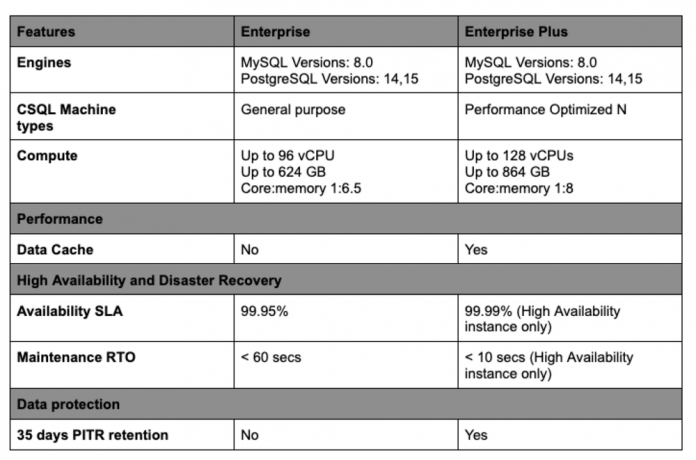The launch of Cloud SQL Enterprise Plus edition back in July introduced three major enhancements to Cloud SQL: substantial improvements in read and write performance, near-zero downtime for planned maintenance operations coupled with a 99.99% Service Level Agreement (SLA), and expanded data protection features. To make it easy for you to use Enterprise Plus edition, today, we are announcing in-place upgrade from Enterprise edition to Enterprise Plus edition, which provides a seamless in-place upgrade path with minimal disruption (anticipated downtime of < 60 seconds).
This is great news for Cloud SQL customers that can now leverage the enhanced SLA and data protection in Cloud SQL Enterprise Plus, as well as near-zero downtime maintenance operations.
“Cloud SQL Enterprise Plus allowsID.meto more easily meet our compliance requirements with features such as 35 day PITR and four 9’s of availability. The process of upgrading from Enterprise edition to Enterprise Plus edition was incredibly easy.” – Kevin Liu – Cloud Platform Architect, ID.me
The main differences between Cloud SQL Enterprise and Enterprise Plus editions, as of this release.
Introduction to in-place upgrade
In-place upgrade provides a one-click experience for Cloud SQL customers. The upgrade takes a few minutes to finish, with an anticipated downtime of < 60 seconds. Notably, this process should not require any changes to application-level endpoints. Last but not least, all existing operational workflows and flags will work unchanged after the upgrade: The existing instance will retain its name and IP address, eliminating the need for any application reconfiguration/redeployment.
For customers who want to go back to Enterprise edition, we also provide a downgrade workflow that also provides minimal disruption (P90 downtime < 60 seconds).
Upgrading an Enterprise edition instance to Enterprise Plus edition
To upgrade an existing instance of Cloud SQL Enterprise edition to Enterprise Plus edition, here are the appropriate flags:
–edition=ENTERPRISE_PLUS (Required)–tier=instance size specified by core count, all valid values for Enterprise Plus are: (Required)–project=<project_id>–enable-data-cache (enables data-cache to further accelerate read performance)
Verifying edition upgrade status
Downgrading an Enterprise Plus instance to Enterprise
To downgrade an existing Enterprise Plus instance to Enterprise, here are the appropriate flags:
–edition=ENTERPRISE–tier=<instance size specified by core count and memory size>–project=<project_id>
As part of the downgrade, Data Cache will be automatically disabled.
Conclusion
By leveraging Cloud SQL’s new in-place upgrade feature, customers can now easily migrate their existing Cloud SQL Enterprise edition instances to Enterprise Plus edition, without having to migrate their data or using external tooling. This is a significant operational improvement over manually migrating to new Enterprise Plus instances. The in-place upgrade feature is fully automated and can be completed in a matter of minutes with minimal downtime.
Once the upgrade is complete, the new instance will be running on the specified version and hardware tier, while retaining its prior name and IP address, without any need to reconfigure or redeploy applications.
To learn more about Cloud SQL editions, please visit the official documentation here.
Cloud BlogRead More


